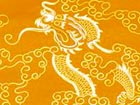| Videos | • Latest |
|
• Feature | • Sports | • Your Videos |
Revival of traditional craft: wax powder paper

 0 Comment(s)
0 Comment(s) Print
Print E-mail CNTV, February 14, 2012
E-mail CNTV, February 14, 2012
Paper is one of the greatest inventions of Chinese people. There is a special kind of paper that was only used for imperial edicts. It's called wax powder paper. It first appeared during the Tang Dynasty, reaching its peak in the Qing Dynasty, but it disappeared along with China's last emperor. Fortunately, the craft has been rediscovered and given new life.
 |
|
Revival of traditional craft: wax powder paper. |
The man painting the wax powder paper is Liu Jing, national inheritor of the craft. Part of what makes each work another treasure of wax powder paper is that he uses genuine gold and does everything by hand.
For centuries, the paper was used exclusive for royal family, especially for emperors to write his imperial edicts on, due to its luxurious patterns and complex craftsmanship.
Powder absorbs ink while wax preserves it. The perfect combination makes the paper smooth for writing and lasting a long time. After the craft had been lost, many tried to discover its secret from history books. Few succeeded.
Liu said:" Many people wanted to make the paper, but their problem is short durability, either easily chapped or getting crisp before long."
Having diagnosed the problem, Liu Jing started to look for qualified raw material. That was back in 1997.
"I collected all kinds of powder and wax. After four months of searching and experimenting, I finally found it." He recalled.
In 1999, Liu Jing's paper went into mass production. To keep the paper from touching as it dried, their workshop must be a wind-free zone. So tiptoeing is Liu's walking style.
In 2008, wax powder paper was listed as National Intangible Culture Heritage, and Liu's career stepped up to another level. New products have been invented and his markets have expanded to Japan. And cultural sections of the government are also lending a helping hand.
Liu Jing said:"In 2011, the government gave me a grant of 46 thousand dollars. I spent the money renting a school and recruiting students. I want to have a place for displaying and teaching."
15 years have passed since Liu started from scratch to revive the lost craft. And now in 2012 he's not just focused on his accomplishments, but rather how much farther he can go.






Go to Forum >>0 Comment(s)